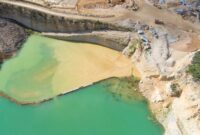Seabed mining investments are gaining global attention as industries and governments look to tap into untouched resources hidden beneath the ocean floor. These deposits contain vast amounts of valuable minerals, metals, and rare earth elements essential for modern technology and sustainable energy solutions. With increasing demand for these resources and the limitations of land-based mining, seabed mining offers a new frontier for growth. This article explores the potential of seabed mining investments, the benefits, risks, and future outlook, and why it’s an opportunity that investors should not overlook.
What is Seabed Mining?
Seabed mining refers to the extraction of mineral resources from the ocean floor. These resources include metals like copper, gold, silver, zinc, and rare earth elements, crucial for various industries, especially electronics and renewable energy. The seabed holds significant quantities of these elements in the form of polymetallic nodules, seafloor massive sulfides, and cobalt-rich ferromanganese crusts. These deposits have remained largely untouched due to the technological and logistical challenges of mining in deep waters. However, advancements in technology are now making it possible to explore and exploit these resources.
The Potential of Seabed Mining Investments
The ocean floor is believed to contain more mineral wealth than the entire Earth’s landmass, offering a vast opportunity for seabed mining investments. As the global demand for metals and minerals continues to rise, especially with the shift towards electric vehicles, wind turbines, and other green technologies, seabed mining provides an untapped solution. Companies and investors venturing into this space can secure a future in which these essential materials become increasingly scarce.
Moreover, seabed mining can address the challenges of declining ore grades on land, reducing the environmental impacts of traditional mining activities. The vastness of the ocean floor also means that exploration and extraction could potentially yield resources that are otherwise difficult or impossible to find on land. For investors, this opens up possibilities for long-term profitability as the demand for these critical minerals continues to grow.
Benefits of Seabed Mining Investments
- Untapped Resources: The ocean floor remains largely unexplored, with an abundance of mineral deposits that have not been extracted yet. Seabed mining investments allow for the exploitation of these resources, providing a competitive edge for those who enter the market early.
- Increased Demand for Rare Earth Elements: With the rise of technologies such as electric vehicles, renewable energy infrastructure, and electronics, the demand for rare earth elements and critical metals is surging. Seabed mining offers a solution to the scarcity of these materials, ensuring a steady supply for future industries.
- Environmental Considerations: While land-based mining can lead to deforestation, habitat destruction, and pollution, seabed mining presents a more sustainable alternative when properly managed. With stringent regulations and the development of environmentally friendly extraction technologies, the environmental impact can be minimized.
- Job Creation and Economic Growth: Seabed mining investments have the potential to create thousands of jobs in various sectors, from exploration and research to technology development and extraction. In addition, the revenues generated from seabed mining can significantly boost the economies of participating countries.
Risks and Challenges of Seabed Mining
While seabed mining presents lucrative opportunities, there are also significant risks and challenges that investors need to consider:
- Environmental Risks: Seabed mining could disrupt delicate marine ecosystems, affecting biodiversity and ocean health. The removal of seafloor material could have unknown long-term effects on ocean life, and there is a risk of chemical contamination.
- Technological Barriers: Mining at depths of several thousand meters presents enormous technological challenges. The equipment required to extract resources from such depths is still in the development stages, and large-scale mining operations in the ocean remain a complex and expensive endeavor.
- Regulatory and Legal Challenges: Seabed mining is subject to international laws and regulations. The International Seabed Authority (ISA) governs the exploration and extraction of resources in international waters. Investors must navigate complex legal frameworks and ensure compliance with environmental and sustainability standards.
- Unpredictable Costs: Due to the novelty of seabed mining, accurate cost projections are difficult to make. Factors such as the development of new technology, unforeseen environmental impacts, and logistical challenges can drive up costs, potentially affecting returns on investment.
Future Outlook for Seabed Mining Investments
Despite the challenges, seabed mining is poised to become a major industry in the coming decades. As traditional land-based resources become depleted, and technological advancements make deep-sea mining more feasible, we can expect to see a surge in seabed mining operations. Countries like Japan, China, and Norway are already making significant strides in seabed exploration, investing heavily in research and development to capitalize on this new frontier.
Investors who are looking for long-term, high-reward opportunities should keep a close eye on developments in this sector. Seabed mining investments could provide substantial returns as the demand for rare earth elements and critical minerals increases, especially with the global shift towards cleaner energy and advanced technology.
How to Get Started in Seabed Mining Investments
- Research the Market: Investors interested in seabed mining should begin by thoroughly researching the industry. Understanding the technology, legal frameworks, and potential environmental impacts is crucial to making informed investment decisions.
- Partner with Experts: Given the complexity of seabed mining, it is essential to partner with companies or experts who have experience in this field. Collaborating with established players in the industry can help mitigate risks and ensure compliance with regulations.
- Stay Informed About Regulations: Since seabed mining is heavily regulated, it is important to stay up-to-date on legal developments. International laws and environmental guidelines will continue to evolve as the industry grows, and investors must ensure that their ventures are compliant.
- Diversify Investments: Seabed mining is still an emerging industry, and like any investment, there are risks involved. Diversifying your portfolio across different sectors can help minimize potential losses and ensure a more balanced investment strategy.
Conclusion
Seabed mining investments offer an exciting opportunity to tap into vast, untouched resources beneath the ocean. As technology advances and demand for rare earth elements and critical minerals grows, seabed mining is set to become a significant industry. However, it is not without its challenges, from environmental concerns to regulatory hurdles. Investors must weigh the potential rewards against the risks and proceed with caution, but for those willing to navigate this complex industry, the future holds enormous potential.
FAQ
Q: What is seabed mining?
A: Seabed mining involves extracting mineral resources from the ocean floor, including metals like copper, gold, silver, and rare earth elements essential for modern technologies.
Q: What are the benefits of seabed mining investments?
A: Seabed mining offers access to untapped resources, meets the rising demand for rare earth elements, and can be more environmentally sustainable compared to land-based mining.
Q: What are the risks of seabed mining?
A: Environmental risks, technological challenges, legal complexities, and unpredictable costs are the primary concerns in seabed mining.
Q: How can investors get involved in seabed mining?
A: Investors should research the market, partner with experts, stay informed about regulations, and consider diversifying their investment portfolios to mitigate risks.
By investing in seabed mining, forward-thinking individuals and companies can position themselves at the forefront of a revolutionary industry set to shape the future of resource extraction.




